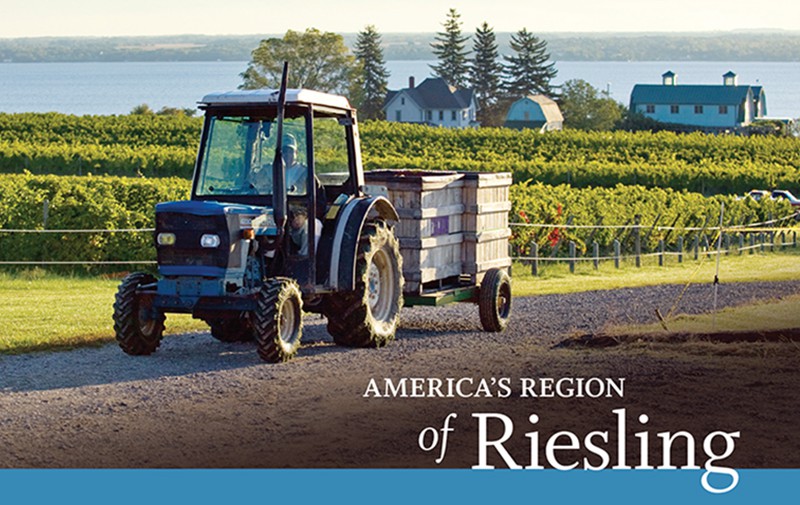
Ask any sommelier what he or she wishes people would drink more of, and nine out of ten will answer Riesling. Rieslings are the epitome of versatility, simultaneously delicate and powerful, muscular and graceful, the modern dancers of the wine world. So when it comes to cheese—with its delicate, milky nuances yet formidable fat—Riesling is a no-brainer.
However, if you want to test out the adage that what grows together goes together, it’s not so easy with Riesling. The most famous Rieslings come from Germany’s Mosel Valley, but I’ll be damned if I can find a Mosel cheese stateside (I can’t actually think of any I’ve eaten there, either). For Austria’s nervy, bone-dry Rieslings, there’s Bergkäse, but it takes some searching to find even that. And good luck finding South Australian cheeses to go with Clare Valley’s limey versions.
But you can head to New York State, where the Finger Lakes region is putting out some of the best Rieslings in the nation—and a slew of great cheeses to boot. Vines have been grown along the region’s deep, glacier-carved lakes for more than a century, and over the last decade the area has blossomed, now boasting some two hundred wineries. While early winemaking attempts were focused on hybrids bred to withstand the region’s brutal winters, local winemakers have found that Riesling excels in the Finger Lakes climate and soils.
The lakes themselves are integral to their success. Most of the vineyards are gathered along the banks of the central 4 of the region’s 11 lakes—Canandaigua, Keuka, Cayuga, and Seneca. Just as Germany’s Mosel River moderates the chill climate of its surrounding wine region, and Austria’s Danube channels a refreshing breeze through the vines that line its banks, these long, skinny lakes moderate the winter chill and sweaty summer heat common in central New York State.
What’s more, the Finger Lakes region is rich in shale, a precursor of slate, the stone that’s essential to the identity of many Mosel Rieslings. Finger Lakes Rieslings actually exhibit the character that sommeliers go crazy for in Riesling—and which is nearly impossible to find in other American examples: minerality, or a sense of the earth from which they came.
Great cheese, of course, shares this ability to channel not just the flavor of its ingredients but also the flavor of a place, through notes of earth, herbs, and pure, warm animal funk.
This is the factor that got me thinking: If the soil is detectable in a glass of Finger Lakes Riesling, then what will happen when it meets a cheese made from the milk of animals that grazed so nearby? Will the experience be any richer than drinking a Finger Lakes Riesling with a California cheese? Honestly, after a winter of happy experimentation, I can’t say that I know for sure. Was it the freshness of Lively Run’s chèvre that made it feel so alive next to the zippy, lean Ravines Argetsinger Vineyard Dry Riesling, or something more?
Does Treleaven’s Riesling go so well with Bronson Hill Cheesery’s Red Meck because they are both born of Cayuga Lake or simply because the wine can handle the rich density of the sweet, milky cheese? Did I fall hard for Hillcrest’s cheese curds with Salmon Run Riesling because there’s a subtle synchronicity there or because I’m a pushover for cheese curds and budget Riesling? Can there be a better match for the creamy, pungent Cayuga Blue than the coating richness of Hermann J. Wiemer’sa honeyed, late-harvest 2009 Riesling?
All questions I have chewed on. Now that there’s a Finger Lakes cheese trail map to go with the region’s four wine trail maps, you can, too. The answers are just a drive away.
Finger Lakes Fare
The best way to explore Finger Lakes wines and cheeses is to go there, since many of them don’t make it much past local stores. Until you can get there, here are some of the best of the more widely available wines and cheeses to search out.
Local Wines
(from dry to sweet)
- Fox Run 2008 Finger Lakes Riesling ($14)
- Treleaven 2008 Cayuga Lake Dry Riesling ($15)
- Ravines 2008 Finger Lakes Argetsinger Vineyard Dry Riesling ($25)
- Salmon Run 2009 Finger Lakes Riesling ($12)
- Dr. Konstantin Frank 2008 Finger Lakes Semi Dry Riesling ($15)
- Hermann J. Wiemer 2009 Finger Lakes Late Harvest Riesling ($35)
Local Cheeses
- Bronson Hill Cheesery Dutch-style Schuyler and French-style Red Meck
- Hillcrest Dairy cheese curds (315-497-0659)
- Keeley’s Cheese at McGarr Farms Pondhopper, a raw cow’s milk semisoft washed rind, and Brida con Vino, a creamy round washed in Treleaven’s Dry Riesling
- Lively Run Goat Cheese chèvre, feta, and Cayuga Blue
- Meadowood Farms Brébis, Boursin
- Muranda Cheese Company British-style cheddar, Colby





